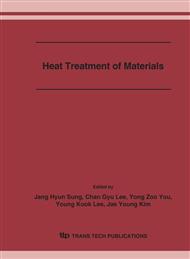p.609
p.615
p.623
p.635
p.639
p.645
p.651
p.655
p.661
The Characteristic Evaluation of Hydroxyapatite Powders Synthesized from CaCO3 Refined from Oyster Shell and H3PO4
Abstract:
Hydroxyapatite (Ca10(PO4)6(OH)2, HAp) powders is synthesized using the mixed powders of CaCO3 refined from oyster shells and phosphoric acid (H3PO4-98%, Daejung) as starting materials. The characteristic evaluation and chemical analysis of the synthesized powders is performed by X-ray diffraction (XRD), Fourier-transformed infra-red spectroscopy (FT-IR), and inductively-coupled plasma atomic emission spectroscopy (ICPAES). XRD analysis of synthetic powder by heat treatment at 1300°C for 2hrs shows only HAp peaks corresponding to stoichiometric HAp. It is confirmed by ICP-AES test that impurities such as Zn, In, Ti, Ba, Cd, Pb, and Mn, is not detected at all, but small amounts of Ti and Be is observed (0.099ppm Ti and 0.002ppm Ba). Variation of bone density is measured by giving medication of HAp powder with drinking water into human body continuously for three month. After the medication, the bone density is higher than the medication before. This means that HAp powder made from this process can be used as improver of bone density.
Info:
Periodical:
Pages:
639-644
Citation:
Online since:
December 2006
Authors:
Price:
Сopyright:
© 2006 Trans Tech Publications Ltd. All Rights Reserved
Share:
Citation:


